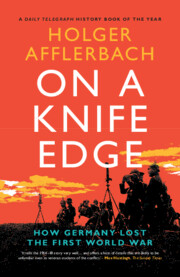Book contents
- On a Knife Edge
- Cambridge Military Histories
- On a Knife Edge
- Copyright page
- Dedication
- Contents
- Figures
- Maps
- Tables
- Abbreviations
- Introduction
- Part I Hubris
- Part II Climax: At the Apex of War
- Part III Nemesis: The Defeat of the Central Powers and the Destruction of the European Order
- The Final Reckoning: A Terrible Debt that Must Be Paid
- Acknowledgements
- Notes
- Bibliography
- Index: People
- Index: Places
Introduction
Published online by Cambridge University Press: 20 October 2022
- On a Knife Edge
- Cambridge Military Histories
- On a Knife Edge
- Copyright page
- Dedication
- Contents
- Figures
- Maps
- Tables
- Abbreviations
- Introduction
- Part I Hubris
- Part II Climax: At the Apex of War
- Part III Nemesis: The Defeat of the Central Powers and the Destruction of the European Order
- The Final Reckoning: A Terrible Debt that Must Be Paid
- Acknowledgements
- Notes
- Bibliography
- Index: People
- Index: Places
Summary
On 26 October 1918 the Swedish military attaché to Germany, Colonel Nils Adlercreutz, called on Lieutenant Colonel Nicolai, the head of German military intelligence, who, like many Europeans at the time, was in bed with flu. He apologised to Nicolai for coming with an unusual but urgent request which was hardly in line with his duties as a neutral military attaché, but explained that after observing four years of ‘our fight’, he felt obliged to speak as a soldier and brother in arms. ‘He urged me’, Nicolai reported, ‘not to lay down our arms’, as ‘he knew the reports of his colleagues from Paris and London.’ Nicolai did not ask for details, but gathered that the governments in both those capitals ‘faced the same internal opposition to a continuation of the war, as we do. If Germany would just remain firm, the enemy’s will to fight on would collapse in the face of the Bolshevik danger.’ Nicolai thanked the Swedish colonel for his intervention, but it had come too late ‘because Ludendorff was dismissed this morning’.
Information
- Type
- Chapter
- Information
- On a Knife EdgeHow Germany Lost the First World War, pp. 1 - 6Publisher: Cambridge University PressPrint publication year: 2022
